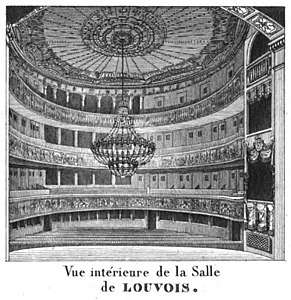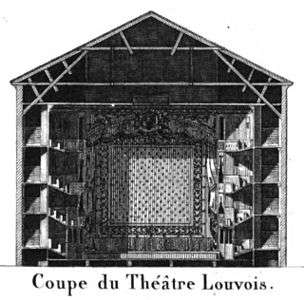Théâtre Louvois
The Théâtre Louvois or Salle Louvois was a theatre located at what is today 8 rue de Louvois in the 2nd arrondissement of Paris. Inaugurated in 1791 and closed in 1825, it was used by the Théâtre-Italien from 20 March 1819 to 8 November 1825.[1] Gioachino Rossini became Director of Music on 1 December 1824.[2]

History
- 1791: building by Francescal on plans by Alexandre-Théodore Brongniart; inauguration on 16 August; known as the Théâtre de Louvois or Théâtre de la rue de Louvois, under the direction of Michel-André Delomel[3]
- 1794–1796: known as the Théâtre des Amis de la Patrie[4]
- 1796: direction Mlle Raucourt, as the Théâtre Français de la rue de Louvois'[3]
- 1798: direction César Ribié, as the Théâtre d'Émulation[3]
- 1799: used by the players of the Théâtre de l'Odéon under the direction Louis-Benoît Picard[5]
- 1799–1801: known as the Théâtre des Troubadours[6]
- 1801–1808: used again by the players of the Théâtre de l'Odéon under Picard, then Alexandre Duval[7]
- 1804: becomes known as the Théâtre de l'Impératrice until June 1808, when the players return to the new Odéon, taking the name with them[8]
- 1807: acquired in December by the state for use by the Paris Opéra as rehearsal space and for concerts, including some by the Concerts Spirituels[9]
- 1808: closing by order of Napoléon ; it then serves as storage room for the Opéra, at that time performing in the Théâtre des Arts located just across the rue de Louvois from the Salle Louvois; communication between the two buildings was via an iron bridge over the rue de Louvois
- 1811–1812: annex constructed for the storage of scenery[9]
- 1819–1825: primary venue of the Théâtre-Italien[10]
- 1820: after the closing of the Salle Favart, the theatre was used for two performances[11] as an opera house by the Opéra, while the company was awaiting the completion of the Salle Le Peletier[12]
- 1825: closing of the theatre
- 1827: order issued to remove all stored scenery for the sale of the theatre[13]
- 1899: demolition
Architectural drawings of 1821
 View of the auditorium
View of the auditorium Transverse section
Transverse section Plan
Plan
gollark: ...
gollark: osmarks.tk has full UTF-8 capability, fortunately.
gollark: It's just so ææææææ.
gollark: If it wasn't for people needing to use different languages I would NOT support Unicode.
gollark: I have to admit I kind of agree?
Notes
- Wild 1989, p. 197, 232.
- Wild 1989, p. 204.
- Wild 1989, p. 230.
- Wild 1989, p. 39, 230.
- 20 March to 12 April 1799 (Wild 1989, p. 287).
- 1 August 1799 – 20 April 1801 (Wild 1989, p. 230, 403–404).
- 5 May 1801 – 12 June 1808 (Wild 1989, pp. 230, 287).
- Wild 1989, p. 193.
- Wild 1989, p. 232.
- Johnson 1992; Wild 1989, p. 232.
- De Lasalle, (p. 234).
- Wild 1989, p. 299.
- Nicole Wild cites Archives nataionales, O3 1620; also a letter of 13 December 1827 from La Ferté to La Rochefoucauld states that the theatre will be sold for demolition (Wild 1989, p. 232).
Bibliography
- Donnet, Alexis; Orgiazzi, J. (1821). Architectonographie des théâtres de Paris, plates volume, plate 12. Paris: Didot l'ainé. Scanned by Google Books. Credit: Princeton University Library.
- Hillairet, Jacques (1985). Dictionnaire historique des rues de Paris, vol. 2, 8th edition, Les Éditions de minuit, 1985, ISBN 2-7073-1054-9
- Johnson, Janet (1992). "Paris, 4: 1789–1870 (v) Théâtre-Italien", vol. 3, p. 870–871, in The New Grove Dictionary of Opera, edited by Stanley Sadie. New York: Grove, ISBN 9781561592289. Also at Oxford Music Online (subscription required).
- Lasalle, Albert de (1875). Les Treize Salles de l'Opéra, librairie Sartorius, 1875 (chapter X: Salle Favart (1820), p. 234)
- Wild, Nicole (1989). Dictionnaire des théâtres parisiens au XIXe siècle: les théâtres et la musique. Paris: Aux Amateurs de livres. ISBN 9780828825863, ISBN 9782905053800 (paperback). View formats and editions at WorldCat.
| Wikimedia Commons has media related to Théâtre Louvois. |
This article is issued from Wikipedia. The text is licensed under Creative Commons - Attribution - Sharealike. Additional terms may apply for the media files.